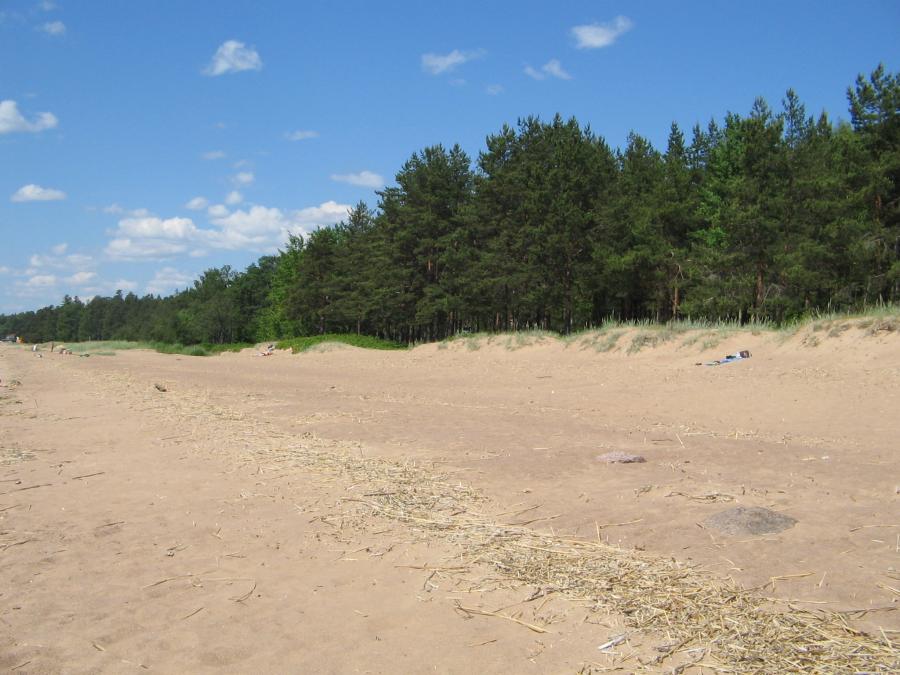Sõnastik (inglise)
Some of the interface text in Estonian and Finnish is machine-translated
| Termin inglise keeles | Termin vene keeles | Termin eesti keeles | Termin soome keeles | Termini tähendus | Foto |
|---|---|---|---|---|---|
| Dunes | Дюны | Luide | Dyyni | (1) accumulations of windblown sand on the backshore, usually in the form of small hills or ridges, stabilized by vegetation or control structures); (2) (megaripples) sedimentary bedforms larger than ripples, greater than 0.6 m in wavelength and greater than around 10 cm in height. Dunes are mostly asymmetrical in profile, with a gentle upcurrent stoss slope and a steeper down-current lee slope, which may be at the angle of repose of the sediment. Dune crestlines may be either linear (two dimensional) or nonlinear (three dimensional, barchan-shape) in plain view. Large dunes may have smaller dunes superimposed upon them. See: Ripple, Sand Wave. |

|
| Dynamic coast classification | Динамическая классификация берегов | Rannikualade dünaamiline klassifikatsioon | Dynaaminen rantojen luokittelu | Developed by V.Zenkovich classification, which treat the processes of evolution of the coast, abrasion process, accumulative process, and takes into account the coast tectonic features (diving, lifting) and the nature of the wave regime. |
|
| Dysphotic zone | Дисфотная зона, также Афиталь | Düsfootiline tsoon | Vähävaloinen vyöhyke | The part of the water column, below the euphotic zone, that receives low levelsof sunlight insufficient to support plant growth. |
|
| Early life stages of fish | Ранние стадии жизненного цикла рыб | Kalade varajane elujärk | Kalojen varhaisvaiheet | Egg and larval stages of fish. |
|
| Ecosystems | Экосистемы | Ökosüsteem | Ekosysteemit | Short for ecological systems. Functional units that result from the interactions of abiotic and biotic components; a combination of interacting, interrelated parts that form aunit. All ecosystems are "open" systems in the sense that energy and matter are transferred in and out. The Earth as a single ecosystem constantly converts solar energy into myriad organic products, and has increased in biological complexity over geologic time. |
|
| Ecotone | Экотон | Ökoton | Ekotoni | A transition zone between two ecologically distinct regions, that may contain specialized species adapted to the gradient in environmental conditions that occurs there. |
|
| Ecotope (biotope) | Экотоп, см. Биотоп | Ökotoop (biotoop) | Ekotooppi (biotooppi) | Both the abiotic and biotic elements of habitats; physical habitats and their associated biota; a geographical unit homogeneous within limits for the most important hydraulic, morphological, and physicochemical environmental factors that are relevant forbiota. |
|
| Eelgrass | Взморник, зостера, морская трава | Pikk merihein (ingl eelgrass) | Ajokas, meriajokas (Zostera marina) | Is a common name for several aquatic phanerogam species from marine Zostera and freshwater Vallisneria genera. Eelgrasses are important keystone species. |
|
| Embayed coast | Бухтовый берег | Liigestunud rannajoon | Rikkonainen rantaviiva | Shore, characterized the winding coastline, which delineates bays and headlands. |
|
| Endangered species | Уязвимые виды | Eriti ohustatud liik | Uhanalainen laji | Species is determined as threatened according to The World Conservation Union (IUCN) criteria which are based on, e.g., the general biology of the species and the changes occurring in its environment. |
